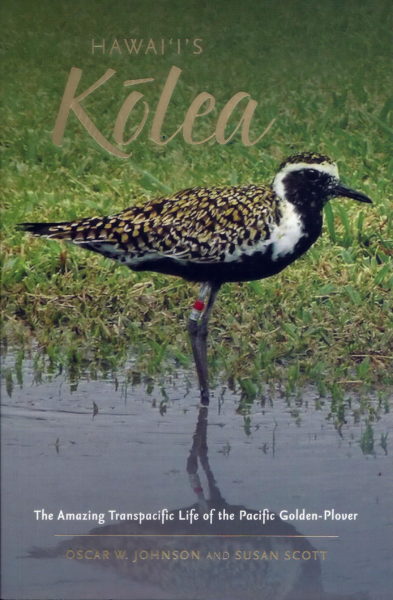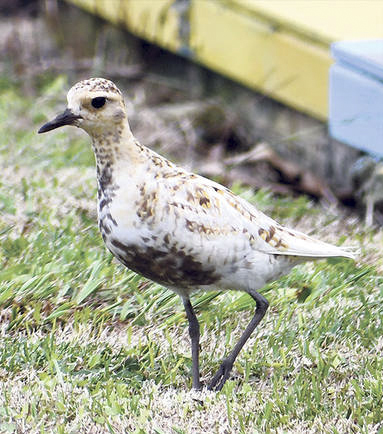Published in the Ocean Watch column, Honolulu Star-Advertiser © Susan Scott
April 21, 2018
Plover admirers, this is the week to wish your neighborhood kolea safe travels. Soon most of Hawaii’s birds will be heading to Alaska, flying nonstop over the Pacific to their tundra nesting grounds. The annual migration, which occurs April 26 or 27, will take three days.
All the kolea fit to fly leave at about the same time, taking their cue by daylight length. Underweight or injured birds will spend the summer with us in Hawaii.
Several readers have written that their backyard plovers are plump and pretty, ready for their passage to parenthood. Mine are, too. Our town house fronts a golf course, and in winter it often takes me a few moments of searching to spot our two resident kolea, one on each side of a monkeypod tree.
Since March, though, I see them in a second. In their spring outfits they stand out against the grass like neon signs.
Those brilliant new feathers are indeed advertisements, showing members of the opposite sex that they’re healthy and fit enough to raise chicks.
No one knows whether the birds begin choosing mates while still in Hawaii, but mine, a male and a female, are foraging closer together than they did all winter.
 Click the image to order Susan’s book on Kolea.
Click the image to order Susan’s book on Kolea.
Once in Alaska, males build cuddly nest cups of lichen and moss. To market his construction skills, the male makes distinct aerial displays called butterfly flights. These energetic midair acrobatics attract females that are shopping around for a handsome mate or perhaps looking for a male they found attractive in Hawaii.
In fall and winter it’s impossible to tell the sexes apart, but come March new breeding feathers start to emerge. Males now have black chins and chests bordered by white racing stripes on each side.
Females’ colors are mottled but still impressive. In both sexes the back and wing feathers make it clear how the species got its English common name, Pacific golden plover. In the sunshine the gold-tipped feathers glimmer like tiny jewels.
The subject of plovers generates more email than all other subjects combined. An email is how I learned about the mostly white plover at Heeia Pier (thank you, Bill). I named the bird Blanche, and he/she now has a fan club, being the only leucistic (mostly white but not albino) kolea ever seen.
Like most of Hawaii’s kolea, Blanche has gained weight, but the bird’s spotty black feathers on its chest and belly aren’t enough to tell whether it’s a male or female. Let’s hope a member of the opposite sex finds Blanche as attractive as we humans do.
Here’s wishing Blanche, and all kolea, fair weather for fast flights. Come August we’ll be welcoming them back.
